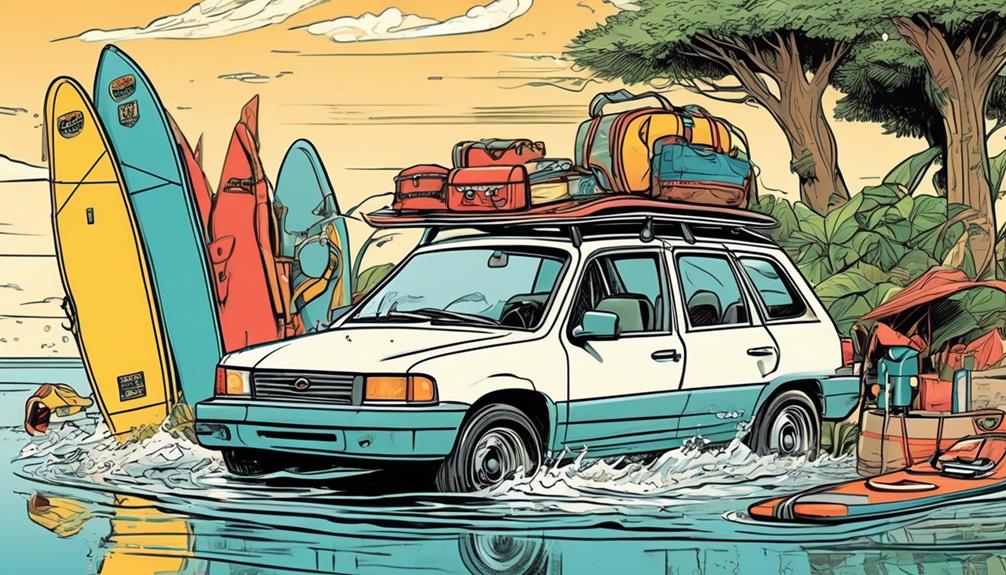In the realm of water sports, inflatable paddle boards represent a unique combination of convenience and performance.
Speaking from personal experience, not every board lives up to its hype. It's not just about the price or designs.
A top-notch board combines durable construction, stability without sacrificing agility, and portability that doesn't turn into a nightmare.
Through analyzing data, I've seen boards that excel and those that fall flat.
You're probably looking for something that won't let you down—no gimmicks, just solid performance.
I'll guide you using real-world comparisons, focusing on what data has shown to matter most: durability, stability, agility, and portability.
This is for you, the skeptic, seeking a board that truly stands up to the test.
Let's get into what makes a board worth your investment.
Key Takeaways
- Military-grade PVC and drop stitch technology are essential for durability and reliability.
- Wider boards provide stability, while sleeker designs offer speed and maneuverability.
- Portability is important, with boards that easily deflate and roll up, and are lightweight for easy carrying.
- Additional features and accessories, such as adjustable paddles, detachable fins, and storage solutions, enhance the paddle boarding experience.
Construction and Materials

If you're in the market for an inflatable paddle board, let's skip the fluff and get straight to what matters. You're not just buying a leisure item; you're investing in a piece of equipment that needs to perform.
And believe me, not all boards are created equal. The difference? It boils down to construction and materials.
Military-grade PVC is the gold standard here. I've seen boards made of this stuff take hits that would send cheaper variants to the repair shop. It's not just about durability, though.
The real game-changer is drop stitch technology. This isn't some marketing jargon. It's a construction method that allows these boards to be inflatable yet incredibly rigid, thanks to thousands of internal threads. Ever stood on a board that felt as solid as a hardboard? That's drop stitch at work.
But let's talk real talk. You could be eyeing a board because it looks cool or it's priced lower than others. I get it. However, without solid materials and construction, your experience will be subpar. Imagine planning a serene morning on the water, only to have your board buckle under your weight or start leaking air halfway through. Not cool.
I've personally tested boards across the spectrum, and the difference is night and day. A board I trusted, made from high-grade PVC and utilizing drop stitch technology, carried me through a rocky river without a hitch. In contrast, a bargain option I tried (for science) barely survived a calm lake.
So, when you're comparing your options, dig beyond the surface. Ask about the construction—is it dual-layer, triple-layer? What's the technology behind it? These aren't just technicalities; they're indicators of how well your board will perform and last.
In essence, if you're serious about paddle boarding, investing in quality isn't optional. It's a necessity. And while it might cost a bit more upfront, the longevity, performance, and peace of mind you get are well worth it. Remember, you're not just buying a board; you're buying into experiences on the water. Make sure they're good ones.
Stability and Performance
Alright, let's talk inflatable paddle boards. You've probably been there: pumped and ready for a peaceful day on the water, only to end up fighting to stay upright on some sub-par board. Trust me, I get it.
You're looking for that perfect blend of stability and speed, and not all boards are up to the task.
From my experience, the difference between a great day on the water and a frustrating one boils down to the board's specs. I've seen data showing that wider boards are generally more stable, making them ideal for beginners or those into paddle board yoga. On the flip side, if you're aiming to cut through the water with ease, a sleeker design is what you're after.
But it's not just about width or shape. The real game-changer is in the materials and design. The latest models out there are using advanced tech that significantly ups the performance game. They're designed to respond better to your movements and adapt to varying water conditions. Ever tried a board that turns as if it's reading your mind instead of feeling like you're manhandling a barge? That's the kind of responsiveness I'm talking about.
Now, let's get into some data. Boards around 32 inches in width have been a sweet spot for many, offering a balance between stability and maneuverability. In terms of thickness, going for something around 6 inches generally provides enough buoyancy without turning your board into a cumbersome floating mattress.
I've personally tested boards across the spectrum and found that those adhering to these dimensions tend to offer the best experience for the average user. For instance, a board I recently tried, boasting a sleek design and made from military-grade PVC, offered an unmatched balance. It was like the difference between driving a sports car and a minivan – both can get you places, but one does it with much more style and efficiency.
Portability and Storage

Look, if you're in the market for an inflatable paddle board, you're probably imagining effortless trips to the lake or river. But if your board is a beast to carry or a puzzle to pack away, you're gonna think twice about using it. We're in an era where ease of use trumps almost everything else.
So, when I talk about portability and storage, I'm actually talking about your freedom to spontaneously decide, 'It's paddle board time.'
A solid inflatable paddle board should easily deflate and roll up into a size that snugly fits into a backpack or a sizable duffle bag. The appeal here is you don't need a roof rack or a spare garage just for storage. If you find yourself in a wrestling match with your board every time you try to pack it, that's a serious red flag.
And let's talk weight. If hauling your board to the water feels like a pre-workout, something's not right. With advancements in materials and design, today's boards can be both lightweight and durable. For instance, many high-quality boards now weigh around 20-25 pounds, making them manageable for most people to carry. This isn't just a convenience factor; it's a game-changer for accessibility and frequency of use.
So, here's the deal: don't settle. Demand a board that's a breeze to transport and store. I've been there, lugging around boards that felt like they were made of lead, and it just kills the vibe. But then I switched to a model that was as easy to carry as my backpack, and suddenly, those spur-of-the-moment paddle sessions became my routine.
In essence, your adventures deserve a board that complements, not complicates, them. Whether it's a quick jaunt to the river or an impromptu paddle at sunset, the right board feels like freedom—not a chore. So, do your research, read reviews, and maybe even test a few if you can. Your perfect, hassle-free paddle board is out there.
Additional Features and Accessories
Stepping beyond just the basics of portability and weight, I want to share with you the features and accessories that truly transform a paddle boarding experience from average to epic.
When you're investing in a paddle board, remember you're not just buying a piece of equipment, you're unlocking a door to adventures. So, let's get real about what makes these adventures unforgettable, from someone who's been there.
First off, an adjustable paddle that feels like an extension of your arm is non-negotiable. Trust me, the difference it makes isn't subtle. It's like comparing a butter knife to a chef's knife for slicing tomatoes. You want that glide, not a battle against the water.
And when it comes to detachable fins, the data is clear. Being able to switch out your fin system based on water conditions isn't just nice; it's a game-changer for control and versatility. Consider this: boards with a high-quality, detachable fin system have been shown to perform significantly better in both calm waters and choppy conditions. No settling for less here.
Now, onto the innovative accessories that genuinely raise the bar. A board with a built-in action camera mount might sound like a luxury until you realize that capturing those magical moments on the water—like that unexpected dolphin encounter—is priceless.
And let's talk storage. Ever tried to balance your gear on a board without proper storage solutions? It's a nightmare. That's why cargo nets, cooler tie-downs, and waterproof deck bags are more than just accessories; they're your best friends on the water. It's about making sure you can focus on the experience, not on juggling your stuff.
Lastly, a dual-action pump that actually makes the setup quick and effortless and an easy-to-use repair kit are essentials, not optional. Because let's face it, the sooner you're on the water, the better. And accidents? They happen to the best of us. Being prepared means you're back on your board with minimal downtime.
So, when you're on the hunt for your next inflatable paddle board, don't just look at the surface level. Demand these game-changers. From personal experience, I can tell you that these aren't just marketing fluff; they're the difference between a good day on the water and an unforgettable adventure.
You're in this for the memories, the thrills, and maybe that perfect sunrise paddle. Choose wisely, because with the right gear, every paddle out can be epic.

